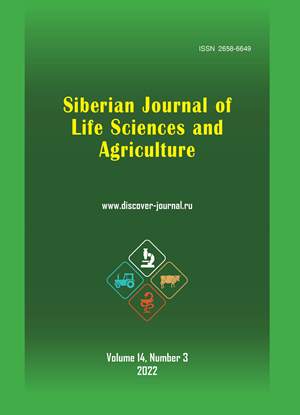ПРИМЕНЕНИЕ СТАНДАРТИЗИРОВАННОГО ИНДЕКСА ОСАДКОВ ДЛЯ ОЦЕНКИ И ПРОГНОЗА АТМОСФЕРНЫХ ЗАСУХ В АЛТАЙСКОМ КРАЕ
Аннотация
Целью исследования является выявление и анализ возможности использования Стандартизированного индекса осадков (ИСО) в Алтайском крае для агроклиматических и метеорологических исследований, в том числе прогнозирования изменения климата и прогнозирования урожайности различных сельскохозяйственных культур. Агроклиматическую оценку атмосферных засух в условиях Алтайского края проводили относительно новым для отечественной агрометеорологии методом. В настоящее время в Российской Федерации и странах СНГ в основном используется гидротермический коэффициент Г.Т. Селянинова (ГТК) для оценки засухи, что позволяет оценить водообеспеченность территории по соотношению характеристик периода с температурой выше 10 °C. Авторы подготовили калькулятор SPI в программной среде Microsoft Excel. В статье представлены графики хода увлажнения за период активного вегетационного периода для 31 метеорологической станции Алтайского края, а также рассчитана частота засушливых явлений для составления модели осадков за период 1964-2020 годов. В статье не приводятся формулы, подробно описанные в литературных источниках. Результаты исследования могут быть использованы при планировании деятельности в сфере сельского хозяйства, разработке экономической стратегии региона и стратегии в отношении адаптации к изменению климата. Исследование выделяет области, которые являются приоритетными для принятия мер по предотвращению неблагоприятных последствий изменения климата. Общие тенденции изменения агрометеорологических показателей были выявлены в тех районах, где они являются наибольшими. Проводится сравнение с результатами работ в отношении других субъектов Российской Федерации и ближнего зарубежья, в которых анализируется возможность использования метода SPI для оценки засух.
Скачивания
Литература
References
Boyarov Ye.N., Abramova S.V., Gershinkova D.A. Bezopasnost’ cheloveka v svete sovremennoy klimaticheskoy tekhniki [Human security in the light of the current climate agenda]. Siberian journal of life sciences and agriculture, 2021, vol. 13, no. 1, pp. 111-133. https://doi.org/10.12731/2658-6649-2021-13-1-111-133
Zolotokrylin A.N., Cherenkova E.A., Titkova T.B. Aridizatsiya zasushlivykh zemel’ okhvatyvayet chasti Rossii i svyaz’ s zasukhami [Aridization of arid lands in the European part of Russia and its connection with droughts]. Izvestiya Rossiiskoi Akademii Nauk. Seriya Geograficheskaya [Proceedings of the Russian Academy of Sciences. Geographical series]. 2020, vol. 84, no. 2, pp. 207-217. https://doi.org/10.31857/S258755662002017X
Isaev E.K., Omurzakova Sh.A. O vozmozhnosti vybora i modelirovaniya zasukh v Kyrgyzstane [On the possibility of drought detection and modeling in Kyrgyzstan]. Vestnik Kyrgyzsko-Rossiyskogo slavyanskogo universiteta [Bulletin of the Kyrgyz-Russian Slavic University]. 2019, vol. 19, no. 8, pp. 145-151.
Kozhakhmetov P.Zh., Iskakov E.A., Baibazarov D.K. Ispol’zovaniye standartizirovannogo indeksa temperatury (SIO) dlya nablyudeniya za sukh v Kazakhstane [Using the Standard Precipitation Index (SPI) to detect droughts in Kazakhstan]. Gidrometeorologiya i ekologiya. Yezhekvartal’nyy nauchno-tekhnicheskiy zhurnal [Hydrometeorology and ecology]. 2016. vol. 1, no. 80, pp. 22-31.
Strashnaya A.I., Tishchenko V.A., Bereza (Chub) O.V., Bogomolova N.A. O vozmozhnosti ispol’zovaniya standartizirovannogo indeksa dinamiki dlya otsenki zasukh i v prognozakh otsenki urozhaynosti zernovykh i zernobobovykh kul’tur [On the possibility of using a standardized precipitation index to detect droughts and in forecasts of quantitative assessment of grain and leguminous crop yields]. Trudy gidrometeorologicheskogo nauchno-issledovatel’skogo tsentra Rossiyskoy Federatsii [Proceedings of the Hydrometeorological Research Center of the Russian Federation]. 2015, no. 375, pp. 81-97.
Sokolskaya E.V., Dolgov Yu.A., Lobkovsky V.A. Mnogofaktornaya model’ kak osnova dlya upravleniya kachestvom okruzhayushchey sredy urbanizirovannykh mestorozhdeniy [Multifactor model as a basis for environmental quality management in urban areas]. Teoreticheskaya i prikladnaya ekologiya [Theoretical and Applied Ecology]. 2018, no. 2, pp. 256-234. https://doi.org/10.25750/1995-4301-2018-2-026-034
Cherenkova E.A., Zolotokrylin A.N. O sravnimosti nekotorykh kolichestvennykh pokazateley postavok [On the comparability of some quantitative drought indices]. Fundamentalnaya i prikladnaya klimatologiya [Fundamental and applied climatology]. 2016. no. 2, pp. 79-94. https://doi.org/10.21513/2410-8758-2016-2-79-94
Shamin S.I. Struktura i soderzhaniye zaklyucheniya o vrednykh i neblagopriyatnykh gidrometeorologicheskikh yavleniyakh, nanesshikh material’nyy i sotsial’nyy ushcherb [Structure and content of the database of information about dangerous and adverse hydrometeorological phenomena that caused material and social damage]. Trudy vserossiyskogo nauchno-issledovatel’skogo instituta gidrometeorologicheskoy informatsii - mezhdunarodnogo tsentra dannykh [Proceedings of the All-Russian Research Institute of Hydrometeorological Information]. 2018, no. 182, pp. 144-158.
Al-Khafaji M.S., Al-Ameri R.A. Evaluation of drought indices correlation for drought frequency analysis of the Mosul dam watershed. IOP conference series: earth and environmental science, 2021, vol. 779, e012077. https://doi.org/10.1088/1755-1315/779/1/012077
Chitedze I., Chikabvumbwa S.R. Assessing the impact of spatio-temporal drought regimes using timescale standardized precipitation index in Malawi. Journal of sustainable development of energy, water and environment systems, 2021, vol. 9, no. 4, e1080341. https://doi.org/10.13044/j.sdewes.d8.0341
Karatayev M., Clarke M., Salnikov V., Bekseitova R., Nizamova M. Monitoring climate change, drought conditions and wheat production in Eurasia: the case study of Kazakhstan. Heliyon, 2021, vol. 8, no. 1, e08660. https://doi.org/10.1016/j.heliyon.2021.e08660
Keyantash J. The climate data guide: Standardized precipitation index (SPI), 2018. URL: https://climatedataguide.ucar.edu/climate-data/standardized-precipitation-index-spi
Khadka D., Babel M.S., Shrestha S., Virdis S.G.P., Collins M. Multivariate and multi-temporal analysis of meteorological drought in the northeast of Thailand. Weather and climate extremes, 2021, vol. 34, e100399. https://doi.org/10.1016/j.wace.2021.100399
Liu Q., Zhang J., Zhang H., Yao F., Bai Yu., Zhang S., Meng X., Liu Q. Evaluating the performance of eight drought indices for capturing soil moisture dynamics in various vegetation regions over China. Science of the total environmen, 2021, vol. 789, e147803. https://doi.org/10.1016/j.scitotenv.2021.147803
Lloyd-Hughes B., Saunders M.A. A drought climatology for Europe. International Journal of climatology: a journal of the royal meteorological society, 2002, vol. 22, no. 13, pp. 1571-1592. https://doi.org/10.1002/joc.846
Mahmoudi P., Ghaemi A., Rigi A., Amir Jahanshahi S.M. Recommendations for modifying the Standardized Precipitation Index (SPI) for Drought Monitoring in Arid and Semi-arid Regions. Water resources management, 2021, vol. 35, no. 10, pp. 3253-3275. https://doi.org/10.1007/s11269-021-02891-7
McKee TB, Doesken NJ, Kleist J. The relationship of drought frequency and duration to time scales. Eighth conference on applied climatology, Anaheim, Department of Atmospheric Science Colorado State University, 1993. https://www.droughtmanagement.info/literature/AMS_Relationship_Drought_Frequency_Duration_Time_Scales_1993.pdf
Prajapati V.K., Khanna M., Singh M. Kaur R., Sahoo R.N., Singh D.K. Evaluation of time scale of meteorological, hydrological and agricultural drought indices. Natural hazards, 2021, vol. 109, pp. 89-109. https://doi.org/10.1007/s11069-021-04827-1
Sohn S.-J., Tam C.-Y., Ashok K., Ahn J.-B. Quantifying the reliability of precipitation datasets for monitoring large-scale East Asian precipitation variations. International journal of climatology, 2012, vol. 32, no. 10, pp. 1520-1526. https://doi.org/10.1002/joc.2380
Svoboda M., Fuchs B. Handbook of drought indicators and indices, 2016. URL: https://www.droughtmanagement.info/literature/GWP_Handbook_of_Drought_Indicators_and_Indices_2016.pdf
Yaseen Z.M., Ali M., Sharafati A., Al-Ansari N., Shahid S. Forecasting standardized precipitation index using data intelligence models: regional investigation of Bangladesh. Scientific reports, 2021, vol. 11, e3435. https://doi.org/10.1038/s41598-021-82977-9
Список литературы
Бояров Е.Н., Абрамова С.В., Гершинкова Д.А. Безопасность человека в свете современной климатической повестки // Siberian journal of life sciences and agriculture. 2021. Т.13. №1. С. 111-133. https://doi.org/10.12731/2658-6649-2021-13-1-111-133
Золотокрылин А.Н., Черенкова Е.А., Титкова Т.Б. Аридизация засушливых земель Европейской части России и связь с засухами // Известия Российской академии наук. Серия географическая. 2020. Т.84. №2. С. 207-217. https://doi.org/10.31857/S258755662002017X
Исаев Э.К., Омурзакова Ш.А. О возможности выявления и моделировании засух в Кыргызстане // Вестник Кыргызско-Российского славянского университета. 2019. Т.19. №8. С. 145-151.
Кожахметов П.Ж., Искаков Е.А., Байбазаров Д.К. Использование стандартизированного индекса осадков (СИО) для выявления засух в Казахстане // Гидрометеорология и экология. Ежеквартальный научно-технический журнал. 2016. Т.1. №80. С. 22-31.
О возможности использования стандартизированного индекса осадков для выявления засух и в прогнозах количественной оценки урожайности зерновых и зернобобовых культур / Страшная А.И., Тищенко В.А., Береза (Чуб) О.В., Богомолова Н.А. // Труды гидрометеорологического научно-исследовательского центра Российской Федерации. 2015. №357. С.81-97.
Сокольская Е.В., Долгов Ю.А., Лобковский В.А. Многофакторная модель как основа для управления качеством окружающей среды урбанизированных территорий // Теоретическая и прикладная экология. 2018. № 2. С. 256-234. https://doi.org/ 10.25750/1995-4301-2018-2-026-034
Черенкова Е.А., Золотокрылин А.Н. О сравнимости некоторых количественных показателей засухи // Фундаментальная и прикладная климатология. 2016. № 2. С. 79-94. https://doi.org/10.21513/2410-8758-2016-2-79-94
Шамин С.И. Cтруктура и содержание базы сведений об опасных и неблагоприятных гидрометеорологических явлениях, нанесших материальный и социальный ущерб / Труды всероссийского научно-исследовательского института гидрометеорологической информации - мирового центра данных. 2018. №182. С. 144-158.
Al-Khafaji M.S., Al-Ameri R.A. Evaluation of drought indices correlation for drought frequency analysis of the Mosul dam watershed // IOP conference series: earth and environmental science, 2021, vol. 779, e012077. https://doi.org/10.1088/1755-1315/779/1/012077
Chitedze I., Chikabvumbwa S.R. Assessing the impact of spatio-temporal drought regimes using timescale standardized precipitation index in Malawi // Journal of sustainable development of energy, water and environment systems, 2021, vol. 9, no. 4, e1080341. https://doi.org/10.13044/j.sdewes.d8.0341
Karatayev M., Clarke M., Salnikov V., Bekseitova R., Nizamova M. Monitoring climate change, drought conditions and wheat production in Eurasia: the case study of Kazakhstan // Heliyon, 2021, vol. 8, no. 1, e08660. https://doi.org/10.1016/j.heliyon.2021.e08660
Keyantash J. The climate data guide: Standardized precipitation index (SPI), 2018. URL: https://climatedataguide.ucar.edu/climate-data/standardized-precipitation-index-spi
Khadka D., Babel M.S., Shrestha S., Virdis S.G.P., Collins M. Multivariate and multi-temporal analysis of meteorological drought in the northeast of Thailand // Weather and climate extremes, 2021, vol. 34, e100399. https://doi.org/10.1016/j.wace.2021.100399
Liu Q., Zhang J., Zhang H., Yao F., Bai Yu., Zhang S., Meng X., Liu Q. Evaluating the performance of eight drought indices for capturing soil moisture dynamics in various vegetation regions over China // Science of the total environmen, 2021, vol. 789, e147803. https://doi.org/10.1016/j.scitotenv.2021.147803
Lloyd-Hughes B., Saunders M.A. A drought climatology for Europe // International Journal of climatology: a journal of the royal meteorological society, 2002, vol. 22, no. 13, pp. 1571-1592. https://doi.org/10.1002/joc.846
Mahmoudi P., Ghaemi A., Rigi A., Amir Jahanshahi S.M. Recommendations for modifying the Standardized Precipitation Index (SPI) for Drought Monitoring in Arid and Semi-arid Regions // Water resources management, 2021, vol. 35, no. 10, pp. 3253-3275. https://doi.org/10.1007/s11269-021-02891-7
McKee TB, Doesken NJ, Kleist J. The relationship of drought frequency and duration to time scales // Eighth conference on applied climatology, Anaheim, Department of Atmospheric Science Colorado State University, 1993. https://www.droughtmanagement.info/literature/AMS_Relationship_Drought_Frequency_Duration_Time_Scales_1993.pdf
Prajapati V.K., Khanna M., Singh M. Kaur R., Sahoo R.N., Singh D.K. Evaluation of time scale of meteorological, hydrological and agricultural drought indices // Natural hazards, 2021, vol. 109, pp. 89-109. https://doi.org/10.1007/s11069-021-04827-1
Sohn S.-J., Tam C.-Y., Ashok K., Ahn J.-B. Quantifying the reliability of precipitation datasets for monitoring large-scale East Asian precipitation variations // International Journal of climatology, 2012, vol. 32, no. 10, pp. 1520-1526. https://doi.org/10.1002/joc.2380
Svoboda M., Fuchs B. Handbook of drought indicators and indices, 2016. URL: https://www.droughtmanagement.info/literature/GWP_Handbook_of_Drought_Indicators_and_Indices_2016.pdf
Yaseen Z.M., Ali M., Sharafati A., Al-Ansari N., Shahid S. Forecasting standardized precipitation index using data intelligence models: regional investigation of Bangladesh // Scientific reports, 2021, vol. 11, e3435. https://doi.org/10.1038/s41598-021-82977-9
Просмотров аннотации: 213 Загрузок PDF: 195
Copyright (c) 2023 Nina B. Maximova, Nikita M. Pochyomin, Gennady G. Morkovkin, Svetlana S. Slazhneva

Это произведение доступно по лицензии Creative Commons «Attribution-NonCommercial-NoDerivatives» («Атрибуция — Некоммерческое использование — Без производных произведений») 4.0 Всемирная.






















































